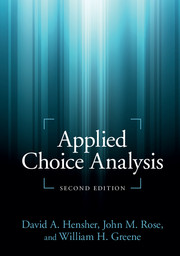9 - Nlogit for applied choice analysis
from Part II - Software and data
Published online by Cambridge University Press: 05 June 2015
Summary
Programming today is a race between software engineers striving to build bigger and better idiot-proof programs, and the Universe trying to produce bigger and better idiots. So far, the Universe is winning.
(Cook, The Wizardry Compiled 1989)Introduction
This book uses the computer program, Nlogit, which will enable you to explore the models that are discussed in the book using your own computer. Nlogit is a a major commercial package published by Econometric Software, Inc. (ESI), which is used worldwide by discrete choice modelers in many disciplines such as Transport, Economics, Agriculture, Health, Marketing, Statistics, and all the social sciences (you might want to visit the website, www.NLOGIT.com). This chapter will describe how to install and use this program on your computer.
About the software
About Nlogit
Nlogit is an extension of another very large, integrated econometrics package, Limdep, that is used worldwide by analysts of models for regression, discrete choice, sample selection, censored data, count data, models for panel data, etc. Nlogit includes all of the capabilities of Limdep plus the package of estimators for models of multinomial choice, such as the multinomial logit (MNL), multinomial probit (MNP), nested logit, mixed logit, generalized mixed logit, ordered logit, latent class, and several others including a very general non-linear random parameters capability in which users write out their own non-linear in parameter and variables functional forms for estimation as a logit model (see Chapter 19), and, in addition, some tools for analyzing discrete choice models such as the model simulator described elsewhere in this book.
- Type
- Chapter
- Information
- Applied Choice Analysis , pp. 387 - 399Publisher: Cambridge University PressPrint publication year: 2015
- 1
- Cited by

